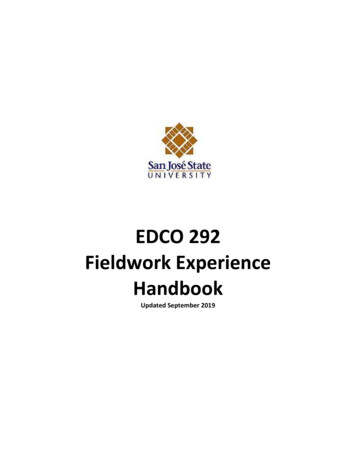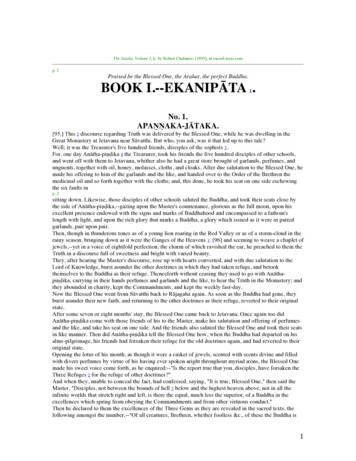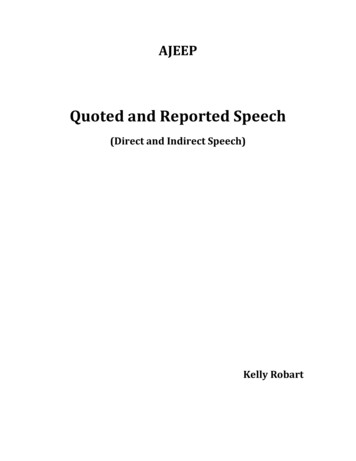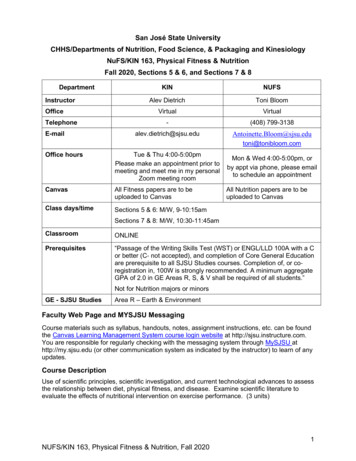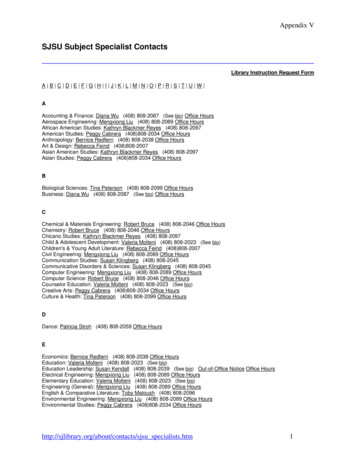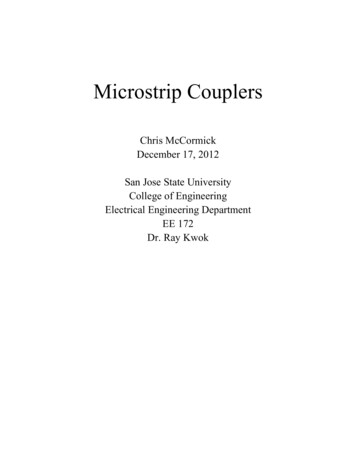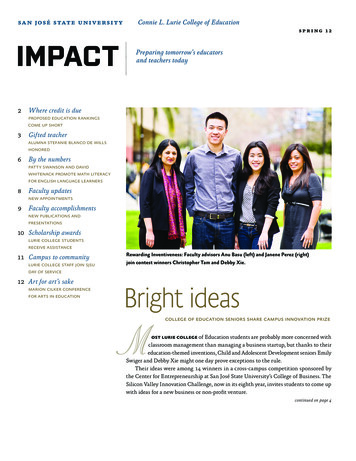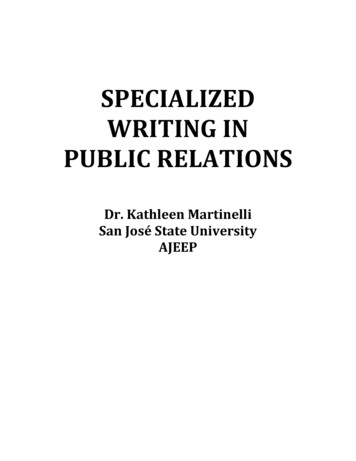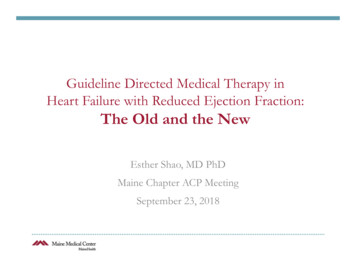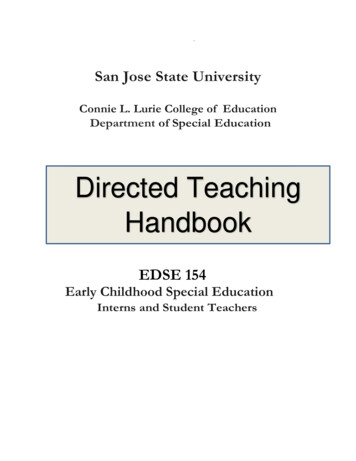
Transcription
.San Jose State UniversityConnie L. Lurie College of EducationDepartment of Special andbookEDSE 154Early Childhood Special EducationInterns and Student Teachers
SJSU SAN JOSESTATE UNIVERSITYDepartment of Special EducationConnie L. Lurie College of E ducationDEPARTMENT OF SPECIAL EDUCATION MISSIONThe Department of Special Education prepares professionals to be effective educators, leaders in the field, andlifelong learners. We accomplish this goal in collaboration with other departments and community partners.Together we promote equity and excellence in our curricula and instruction by infusing evidence based bestpractices endorsed nationally.DIRECTED TEACHING COURSEThe last course taken in the credential programs is the Directed Teaching Course, in which the teachercandidate applies the skills and competencies learned from the credential courses in the program in a class orprogram. This requirement cannot be substituted by any course taken at another institution because of theimportance of the SJSU supervisor observing the candidate's application of the competencies. After receivingcredit in this course, the candidate is recommended for the teaching credential with the application for theCalifornia Commission on Teacher Credentialing. Candidates completing the Directed Teaching Course mustsubmit the SupervisionApplication form the semester prior to completing this requirement with the required documentation.STUDENT TEACHINGStudent teaching is an opportunity for a candidate to practice under the· sponsorship and mentoring of anexperienced special education teacher who has been evaluated as being an excellent teacher and recommendedby the district. This experience is a partnership between the university and the local education agencies to preparefuture teachers. Student teaching is only for students seeking to obtain the Preliminary Education SpecialistCredential.Candidates in the Early Childhood Special Education credential program complete eight weeks in a preschoolprogram and eight weeks working in an Early Start Program with infants and families.The Student Teacher practices co-teaching and solo teaching (or designing and teaching lessons on his/her own)during the 8 week placement or as prescribed by the University Supervisor. If the Candidate needs additionaltime to meet the standards and TPEs, an Improvement Plan will be written. The type of experience will bedetermined by the Master Teacher and University Supervisor.The University Supervisor visits the teacher candidate and observes him/her teaching and makes notes with thestrengths, best practice educational practices observed and suggestions or considerations for improvements on 3occasions per placement, with additional visits if necessary. They meet and/or correspond through email aboutthe notes and make arrangements for the next meeting and observation.
INTERNS: THE DIRECTED TEACHING COURSEPreschool or Infant Toddler Interns complete the directed teaching requirement in their own classroom.EDSE I05 must have been completed with credit (CR) before the directed teaching class. Preschool Internsin the Early Childhood Special Education credential program also complete eight weeks in an Early StartProgram with infants and families. Infant/Toddler Intern teachers also complete eight weeks in a preschoolwith a master teacher.Grades for the Directed Teaching ClassThe Directed Teaching course (EDSE154) is graded on a Credit/No Credit basis. The criteria forearning credit are as follows and outlined in the syllabus:1. Attendance in five Directed Teaching seminars 1x/mo.2 At least 41 points out of 68 points on the Directed Teaching Evaluation completed by theUniversity Supervisor. and/or Master teacher (Preliminary Credential)3 Completion of the Teacher Portfolio with 80% of the points earned, as outlined in assignments green sheetIf there are concerns about the Intern/Student Teacher's teaching, dispositions, connections with students,communication with others in the school setting or parents, or with professional conduct, the UniversitySupervisor will hold a discussion with the candidate about feedback and recommendations. If changes arenot observed by mid semester, an Improvement Plan will be developed that will outline the nature of theproblem, objectives and/or activities necessary for improvement, the person responsible, criteria to meetthe objective (with a description of the positive changes expected), and the deadline. The Candidate, MasterTeacher/ Mentor/Support Provider and the University Supervisor sign the Improvement Plan. If theCandidate does not meet the criteria, he/she may not receive credit (CR) in the course if a candidatereceives No Credit in the course, he/she can register for one additional semester the following year in theDirected Teaching course to attempt to pass this course.Additional Candidate Requirements1. Student Teachers follow the Pacing Guide and discuss with the Master Teacher prior to thestart of the semester, if necessary2. Schedule time to discuss the observation with supervisor immediately following the observation in person or viaanother media3. Complete a video tape or recording of a lesson only in pre-K setting, not in Early Start Home setting.4. Complete Daily Log and have available for supervisor upon visit.
University Supervisor's Requirementsl. Conduct the first Directed Teaching seminar to review the requirements, meet the candidatesand set up appointments. Follow schedule developed by fieldwork coordinator, notify thecandidates and conduct each seminar. Participate in the five seminars.2 Visit and observe the Student Teacher or Intern on at least 3 scheduled occasions in each of thetwo placements (or more if necessary); the first visit should be at least in the first two weeks ofeach placement.3. Meet the Principal or the Administrator in the school (during the first visit, if possible).4. Review the lesson plan or planned activity for the observation period.5. Record/provide written feedback about what was observed; lesson events, instructionalstrategies, Intern/Student Teachers' ability to connect with students, student engagement duringthe observation, collaboration or relationships developed with other teachers, DIS personnel,administrators, parents, the Intern or Student Teachers' professionalism, planning andpreparation and dispositions.6. Evaluate the Student Teacher or Intern on the Directed Teaching Evaluation and theDispositions Evaluation. Enter the Preliminary Credential candidates' scores into Task Stream.7. Notify the Intern or Student Teacher about problems or concerns by at least mid-semester(within 4 weeks in each placement) on the Midterm Evaluation. If necessary, develop anImprovement Plan with the Intern/Student Teacher and Master Teacher.8. Discuss with the Intern/Student Teacher any insights, considerations and recommendationsgained from the observation.9. Assist the Candidate to complete the Candidate Transition Plan at the end of semester.Teaching PortfolioThe Teaching Portfolio is the signature assignment for the directed teaching courses in eachcredential program. The Intern or Student Teacher reflects over the semester about specific areasrelated to the .role of the teacher and places these reflections in the Teaching Portfolio. Thesereflections match the Teacher Performance Expectations (TPEs). The binder is set up accordingto the following:The cover for the Teaching Portfolio is on the next page of this handbook, and should be placedon the cover of a 2" three-ring binder with the Candidate's name and course number.The binder should hold 16 dividers/tabs, labeled with each section A-P and 2 Tabs -Tab landTab 2; place each page following the cover page behind the corresponding divider/tab. Thesepages guide the candidate about the specific reflection. The spine of the binder should alsobe labeled with the Intern/Student Teacher's name.
A reflection is written that addresses each bullet point on these pages and placed in the binderbehind the section page described above; the University Supervisor might have specific timeframe in which the Intern/Student Teacher must complete a section and submit for review.Student should also submit assignments in the portfolio, according to syllabus EDSE 154.
SJSUSAN JOSE STATEUNIVERSITYConnie L. Lurie College of EducationDepartment of Special ster:Date:
SJSUSAN JOSE STATEUNIVERSITYZConnie L. Lurie College of EducationDepartment of Special EducationEDUCATION SPECIALIST:TEACHING PORTFOLIOSECTION AINTRODUCTIONInterns: Include a copy of the Self -Assessment and Induction Plan and all updates.Interns: Reflect about the goals on the Induction Plan. Did you meet the goals at the end of thesemester? Reflect about the process for meeting these goals and include evidence of meeting them(the "proof' that you met thegoals).Interns and Student Teachers: Insert Pacing Guide in this section
SJSUSAN JOSE STATEUNIVERSITYDepartment of Special EducationConnie L. Lurie College of EducationEducation Specialist:TEACHING PORTFOLIOSECTION BTPE l: PEDAGOGICAL SKILLS FOR SUBJECT MATTERINSTRUCTIONInterns/Student Teachers: Reflect about the methods you use to instruct studentsin the early childhood curriculum i.e., DEC Evidence Best Practices. Insert 2reflection assignments here - Early Start and PreschoolInterns/Student Teachers: Include some samples or photos of student work thatconnects with Early Foundations.Student Teachers Only: Ask master teacher how he/she integrates IFSP /IEP goalswith the Early Foundations.Interns/Student Teachers: Insert PREK Video Self- Evaluation of teaching in this section
SJSUSAN JOSE STATEUNIVERSITYDepartment of Special EducationConnie L. Lurie College ofEducationEducation Specialist:TEACHING PORTFOLIOSECTION CTPE 2: MONITORING STUDENTS LEARNING DURING INSTRUCTIONInterns/Student Teachers: Describe the process you and/or your master teacherdevelops and monitors progress on each IEP or IFSP goal for students todetermine how they are progressing.Interns/Student Teachers: Include some examples of progress monitoring data sheets,scored quizzes or exams, project rubricsInterns/Student Teachers: Reflect on the pacing of your instruction and anyadjustments you have made regarding pacing.
SJSUSAN JOSE STATEUNIVERSITYDepartment of Special EducationConnie Lurie College ofEducationEducation Specialist:TEACHING PORTFOLIOSECTION DTPE3: INTERPRETATION AND USE OF ASSESSMENTSInterns/Student Teachers: Reflect about your knowledge regarding assessments that areappropriate for the identification of student, whose cultural, ethnic, gender, or linguisticdifferences may be confused with manifestations of a disability.Interns/Student Teachers: Complete Assessment Assignment and insert report.Student Teacher: Ask your preschool /infant master teacher the difference between anannual, triannual or 30 day interim and initial IBP. Ask what testing is done for a"tri" (or a triennial IEP/IFSP) in this district. Ask if any formal testing is done foran annual IEP. Ask how they handle amendments and learn the procedures to anIEP.Student Teacher: Ask to see how all future known IFSP/IEPs/transitionmeetings are listed on a calendar or spreadsheet. Find out whoschedules the meetings.
SJSUSAN JOSE STATEUNIVERSITYDepartment of Special EducationConnie L. Lurie College of EducationEducation Specialist:TEACHING PORTFOLIOSECTION ETPE 4. MAKING CONTENT ACCESSIBLEInterns/Student Teachers: Describe the process (with examples) for assistingand/ or adjusting lessons for students who do not understand the contentor can't participate in an activity.Interns/Student Teachers: Reflect about your ability to vary instructional strategies to mee studentneeds across special and general education environments. Give some examples.Interns/Student Teachers: Describe the process for and the review of student participation in generaleducation inclusive settings.Interns/Student Teachers: Reflect about strategies for helping students develop socialskills for building constructive relationships between all students.
SJSUSAN JOSE STATEUNIVERSITYDepartment of Special EducationConnie L. Lurie College ofEducationEducation Specialist:TEACHING PORTFOLIOSECTION FTPE 5: STUDENT ENGAGEMENTInterns/Student Teachers: Reflect on your strategies for ensuring that the students have active andequitable participation in lessons.Interns/Student Teachers: Reflect about the social and environmental supports forlearning that are provided for your students. You may include photos ofinteresting ideas/strategies you have observed in other classrooms ortechniques of your master teacher if you’re a student teacher.Interns/Student Teachers: Identify 2 resources for materials and ideas related tosocial skills' training. List websites that might help to support general educationteachers and parents.
Department of Special EducationSJSUSAN JOSE STATEConnie L. Lurie College of EducationUNIVERSITYEducation Specialist:TEACHING PORTFOLIOSECTION GTPE 6: CHRONOLOGICALLY APPROPRIATE OR CHILD-BASEDTEACHINGInterns/Student Teachers: Describe behavior support plans that you developedor in which you participated in the development and include examples.Student Teachers Only: Describe ideas you hope to use in your own classroom for behaviorsupport plans. Be specific.Interns/Student Teachers: What have you learned about yourself in terms ofyour ability to reinforce positive behaviors?Interns/Student Teachers: Complete Best Practice Activity for each placementand insert both here
SJSUSAN JOSE STATEUNIVERSITYDepartment of Special EducationLurie College of EducationEducation Specialist:TEACHING PORTFOLIOSECTION HTPE 7: TEACHING ENGLISH LEARNERSStudent Teachers: Ask your master teacher which students (if any) are Englishlearners. Check the first page of the IEP. It will note whether a child is ELor not. Ask the English language acquisition level of each child classified asEL. Include examples of instructional strategies and goals for EnglishLearners.Interns/Student Teachers: Find out who does the assessment of English learners inyour placements. Meet with him/her and ask about the testing done to assessstudent levels (CELDT). Describe hereInterns/Student Teachers: Is there an EL specialist on the staff? How is the programorganized?Interns Only: Reflect about the English Learners in your class or on your caseload and thestrategies you utilizes to develop students' abilities to comprehend and produce English.
SJSUSAN JOSE STATEUNIVERSITYDepartment of Special EducationLurie College of EducationEducation Specialist:TEACHING PORTFOLIOSECTION ITPE8: LEARNING ABOUT STUDENTSInterns/Student Teachers: Reflect about how you learn about your students andtheir interests, preferences for activities and toys, and abilities. Include anystrategies to do soInterns/Student Teachers: Include photographs of your students, if given permission.
SJSUSAN JOSE STATEUNIVERSITYDepartment of Special EducationConnie L. Lurie College of EducationEducation Specialist:TEACHING PORTFOLIOSECTION JTPE 9: INSTRUCTIONAL PLANInterns/Student Teachers: Reflect and Include at least 7 lesson plans (3/PRE-Kplacement & 4 ES placement) 6 Home Visit forms that you completedthis semester.
SJSUSAN JOSE STATEUNIVERSITYDepartment of Special EducationConnie L. Lurie College of EducationEducation Specialist:TEACHING PORTFOLIOSECTION KTPE 10: INSTRUCTIONAL TIMEInterns/Student Teachers: Reflect about the process for connecting, communicating andcollaborating with the following:1. Designated instructional service providers (speech and language pathologists,occupational therapists, ABA therapists, mental health clinicians, etc)2. general education teachers3. para-educators4. administrators5. psychologists6. families7. agencies
SJSUSAN JOSE STATEUNIVERSITYDepartment of Special EducationConnie L. Lurie College EducationEducation Specialist:TEACHING PORTFOLIOSECTION LTPE J: SOCIAL ENVIRONMENTInterns/Student Teachers: Reflect about your positive behavior class wide plan, rules foryour class or your student teacher work with students, and/or methods for reinforcingpositive behaviors of your students.
SJSUSAN JOSE STATEUNIVERSITYDepartment of Special EducationConnie L. Lurie College EducationEducation Specialist:TEACHING PORTFOLIOSECTION M12. HOME, SCHOOL, COMMUNITY, COLLABORATIONStudent Teachers Only: Describe the process for your future introduction to new students and their parents,guardians or families.Interns Only: Describe the communication and collaboration with family members orguardians of your students and reflect about the effectiveness of your strategies.
SJSU UNIVERSITYSAN JOSE STATEDepartment of Special EducationConnie L.Lurie College of EducationEducation Specialist:TEACHING PORTFOLIOSECTION N·13. PROFESSIONALISMInterns/Student Teachers: Evaluate yourself in your interactions with university, faculty, staff,and other professionals in the field; review your civility and presentation in the office andwhen asking for help or advice in the school.Interns/Student Teachers: Review your communication about students or student informationusing People First Language and professional presentation.Interns/Student Teachers: Review your professionalism related to your conduct andprofessional attire.Interns/Student Teachers: Do you belong to a special education organization? If not, consider joining Councilfor Exceptional Children (CEC) and its Division of Early Childhood.
SJSUSAN JOSE STATEUNIVERSITYDepartment of Special EducationConnie L. Lurie College of EducationEducation Specialist:TEACHING PORTFOLIOSECTION O14.PARTICIPATION IFSP, IEP, & T R A N S I T I O N PROCESSStudent Teachers Only : Comment on your observation of any of the IFSP/IEP/Transitionmeetings.Interns Only: Evaluate your participation in the IFSP/IEP meeting and your collaborationwith parents and others in preparation for and during the meeting.
SJSUSAN JOSE STATEUNIVERSITYDepartment of Special EducationConnie L.Lurie College of EducationEducation Specialist:TEACHING PORTFOLIOSECTION P15. Technology in the ClassroomInterns/Student Teachers: Comment on your use of technology in the classroom to help studentswith diverse learning needs.Interns/Student Teachers: What are your goals for increasing the use of technology in yourcurrent or future program?
APPENDICES Assignment Checklist ECSE Lesson Plan Home Visit Record Form Authorization, Consent & Release Form DEC Recommended Practices, 2014
EDSE 154 – ECSE Student TeachingAssignment Checklist –Student/Intern Teacher:ST INT Assignments12XXXXLesson Plans- ES (4) includes 6home visit forms- Prek (3)Teaching Reflections- ES- PreK3XXBest PracticesAssignment- ES- PreK4XXAssessment Summary 3 goals-Teaching Philosophy- Resume- CBEST scores- unofficial transcriptsDVD – self-evaluationof teaching(ES only if in a centerprogram – not homes)PointsTotal 7010 ptseachTotal 5025 ptseachTotal 5025 ptseach25pointsXX7XXPortfolio2408XXParticipation inSeminars10points(15 each)XUniversity supervisorEvaluationsESFinal- MidtermMaster teacherTotal 45pointsDirected Teaching EvalTotal pointsTitle Page onfront ofnotebookTab 2 – afterTab 1PreKUniversity sup.DTotal 45pointsMidtermDirected Teaching EvalMaster teacher9bGB6PreKB30pointsXMaster teacherJTab 1In front ofSections A - PXEvaluationsESFinal- MidtermPortfoliosection25points59a XPoints Recv’d545Note: Need 436/545 for class credit (80%)Total Points
ECSE LESSON PLANNAME OF CHILD/FAMILY MEMBERNAME OF ACTIVITY----------------DEVELOPMENTAL DOMAIN (S),DEVELOPMENTAL SKILL(S)CA INF/TOD OR PRESCHOOOLFOUNDATION - NAME/#MATERIALS REQUIREDTEACHER'S BEHAVIORSEVALUATION OF CHILD (REN'S) PERFORMANCE:SELF EVALUATION:CHILD'S BEHAVIORS
Home Visit RecordTeacher/Aide:Child's Name:.Date:Specialist/Other:What we did today Parent/Caregiver - Things to do.Teacher/Aide/Specialis
San Jose State University . Connie L. Lurie College of Education . Department of Special Education. Directed Teaching Handbook . EDSE 154. Early Childhood Special Education . The last course taken in the credential progr
